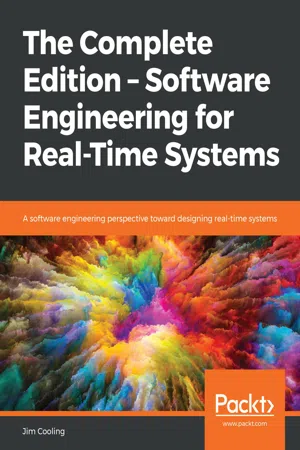
The Complete Edition – Software Engineering for Real-Time Systems
A software engineering perspective toward designing real-time systems
- 824 pages
- English
- ePUB (mobile friendly)
- Available on iOS & Android
The Complete Edition – Software Engineering for Real-Time Systems
A software engineering perspective toward designing real-time systems
About this book
Adopt a diagrammatic approach to creating robust real-time embedded systems
Key Features
- Explore the impact of real-time systems on software design
- Understand the role of diagramming in the software development process
- Learn why software performance is a key element in real-time systems
Book Description
From air traffic control systems to network multimedia systems, real-time systems are everywhere. The correctness of the real-time system depends on the physical instant and the logical results of the computations. This book provides an elaborate introduction to software engineering for real-time systems, including a range of activities and methods required to produce a great real-time system.
The book kicks off by describing real-time systems, their applications, and their impact on software design. You will learn the concepts of software and program design, as well as the different types of programming, software errors, and software life cycles, and how a multitasking structure benefits a system design.
Moving ahead, you will learn why diagrams and diagramming plays a critical role in the software development process. You will practice documenting code-related work using Unified Modeling Language (UML), and analyze and test source code in both host and target systems to understand why performance is a key design-driver in applications.
Next, you will develop a design strategy to overcome critical and fault-tolerant systems, and learn the importance of documentation in system design.
By the end of this book, you will have sound knowledge and skills for developing real-time embedded systems.
What you will learn
- Differentiate between correct, reliable, and safe software
- Discover modern design methodologies for designing a real-time system
- Use interrupts to implement concurrency in the system
- Test, integrate, and debug the code
- Demonstrate test issues for OOP constructs
- Overcome software faults with hardware-based techniques
Who this book is for
If you are interested in developing a real-time embedded system, this is the ideal book for you. With a basic understanding of programming, microprocessor systems, and elementary digital logic, you will achieve the maximum with this book. Knowledge of assembly language would be an added advantage.
Frequently asked questions
- Essential is ideal for learners and professionals who enjoy exploring a wide range of subjects. Access the Essential Library with 800,000+ trusted titles and best-sellers across business, personal growth, and the humanities. Includes unlimited reading time and Standard Read Aloud voice.
- Complete: Perfect for advanced learners and researchers needing full, unrestricted access. Unlock 1.4M+ books across hundreds of subjects, including academic and specialized titles. The Complete Plan also includes advanced features like Premium Read Aloud and Research Assistant.
Please note we cannot support devices running on iOS 13 and Android 7 or earlier. Learn more about using the app.
Information
1. Real-Time Systems – Setting the Scene
- Reduce costs
- Improve quality, reliability, and safety
- Reduce design, development, and commissioning timescales
- Design complex systems
- Build complex systems
- Highlights the differences between general-purpose computer applications (for example, information technology, management information systems, and more) and real-time systems
- Looks at the types of real-time systems met in practice
- Describes the environmental and performance requirements of embedded real-time systems
- Describes the typical structures of modern microprocessors and microcomputers
- Shows, in general, how software design and development techniques are influenced by these factors
1.1 Categorizing Computer Systems
- Batch: I don't mind when the computer results arrive, within reason (the time taken may be hours or even days in such systems).
- Interactive online: I would like the results within a fairly short period of time, typically, a few seconds.
- Real-time: I need the results within definite timescales; otherwise, the system just won't work properly.



1.2 Real-Time Computer Systems
1.2.1 Time and Criticality Issues


1.2.2 Real-Time System Structures
Table of contents
- Preface
- 1. Real-Time Systems – Setting the Scene
- 2. The Search for Dependable Software
- 3. First Steps – Requirements Analysis and Specification
- 4. Software and Program Design Concepts
- 5. Multitasking Systems – an Introduction
- 6. Diagramming – an Introduction
- 7. Practical Diagramming Methods
- 8. Designing and Constructing Software – Code-Related Issues
- 9. Software Analysis and Design – Methods and Methodologies
- 10. Analyzing and Testing Source Code
- 11. Development Tools
- 12. Mission-Critical and Safety-Critical Systems
- 13. Performance Engineering
- 14. Documentation
- Glossary of terms